 Sunday/Weekend
Sunday/Weekend

By Thúy Hằng
For any tourist, a souvenir is an important part of their travel experience because it serves as a tangible reminder of their trip, and they bring home souvenirs to share with their friends and loved ones.
In August, footage of Mexican tourist Arnaud Zein El Din carrying a votive paper horse seen at the check-in counter in Nội Bài International Airport went viral on Vietnamese social media.
The 44-year-old man purchased the cute paper horse for VNĐ100,000 (US$4) in Hà Nội.
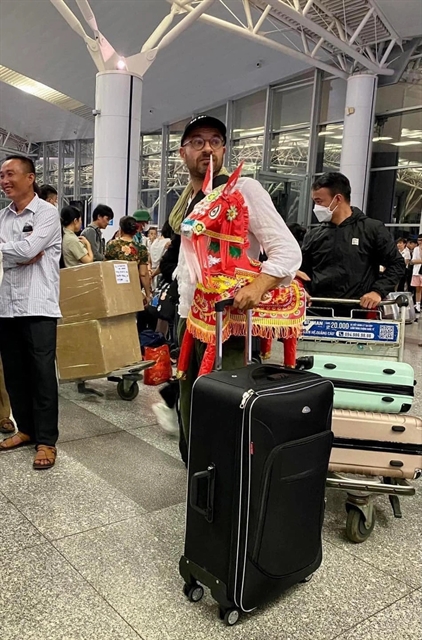 |
| HORSE PLAY: Mexican tourist Arnaud Zein El Din seen with his votive paper horse waiting for boarding at the Nội Bài International Airport. — FB Photo |
He intended to bring it home along with various other items such as conical hats, beer mugs, bamboo masks, sedge mats, and a few local specialities.
At the airport, the tourist successfully passed through the check-in counter and security checkpoint with the horse. However, upon boarding the plane, flight attendants refused to transport the paper horse -- which was oversized according to the airlines' explanation -- and he had to leave it behind. However it triggered a hot debate among netizens as it was a votive item for the dead after all.
All his souvenirs were bought in Hà Nội during his three-week visit to the city.
“There were no suggestions, I just went for a walk and instinctively chose,” El Din said, adding that Hà Nội was a beautiful city that “stole his heart”.
Tour guide Hoàng Thành Điệp who has been working with Saigontours since 2016 said tourist choices depended on their own taste and preferences.
“Tourists from European countries often choose lacquer products while Asians tend to select textile products such as clothes and scarves or handbags,” he said.
Cultural exchange
Souvenirs also foster cultural exchange. They provide an opportunity for tourists to learn about and appreciate different cultures. By purchasing souvenirs, tourists can learn about the history and traditions of a destination, as well as support local artisans and their crafts.
 |
| SHOPPING: Canadian tourist Lee Dev (right) selects a Rubik's cube featuring Hà Nội’s iconic images at a souvenir shop at the Temple of Literature. — VNS Photo Thúy Hằng |
On her second day in Hà Nội, Lee Dev, a young woman from Toronto, Canada, bought her first souvenir – a Rubik's cube with Hà Nội’s iconic images, including the Temple of Literature, Opera House, St Joseph’s Cathedral, One-Pillar Pagoda, Turtle Tower and street vendors. It is among thousands of items available at the souvenir shops at the Temple of Literature.
Lê Xuân Kiêu, director of the Centre for Cultural and Scientific Activities at the Temple of Literature, said that the souvenirs were the result of a research process, aiming to create specific commodities presenting the distinctive features of heritage sites in Hà Nội, and Việt Nam generally.
 |
| CUBIST: Rubik's cubes featuring Hà Nội’s iconic images. — VNS Photo Thúy Hằng |
“The products have been created based on three major criteria – they must be associated with the heritage to promote the cultural and historical values of the site; be connected to Vietnamese craft villages; and made from environmentally friendly materials,” Kiêu told Việt Nam News.
So far, the centre has been working with designers to invent about 50 products that are available for sale at the souvenir shop, which was opened in June. The items include postcards, notebooks, lamps, drink coasters, water bottles, thermos bottles, and mugs.
“Our target is to increase the number of exclusive items to 300 in the next three years, and to 500 in five years. Only designers, who are devoted to the Temple of Literature, can generate great ideas for our souvenir items,” Kiêu said.
While the Centre for Cultural and Scientific Activities at the Temple of Literature operates with its own budget, the Việt Nam Museum of Fine Arts has some financial limitations as it is run with state budget.
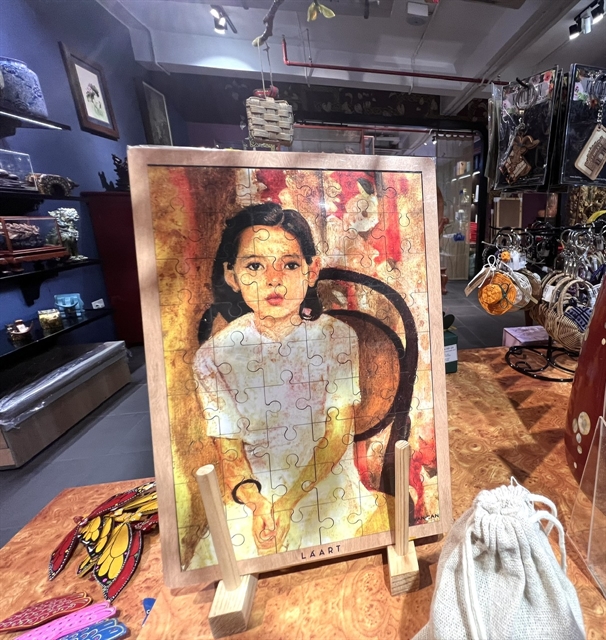 |
| CLASSIC ARTWORK: A puzzle set depicting the ‘national treasure’ – the painting ‘Little Thúy’ by master artist Trần Văn Cẩn. The set is available at a souvenir shop at the Việt Nam Museum of Fine Arts. — VNS Photo Thúy Hằng |
According to Nguyễn Thị Thu Hương, head of the department of communication and external affairs, the museum has been mapping out a strategy to build up their brand as well as create souvenir items associated with the museum.
“Like many museums in the world, we will use the images of famed artworks displayed at the museum in our souvenir products. The items will be made to suit all tastes and prices to guarantee visitors never forget their visit to the museum,” she said.
Hương also mentioned a valuable painting collection of President Hồ Chí Minh that has never been unveiled, which could be used for souvenirs.
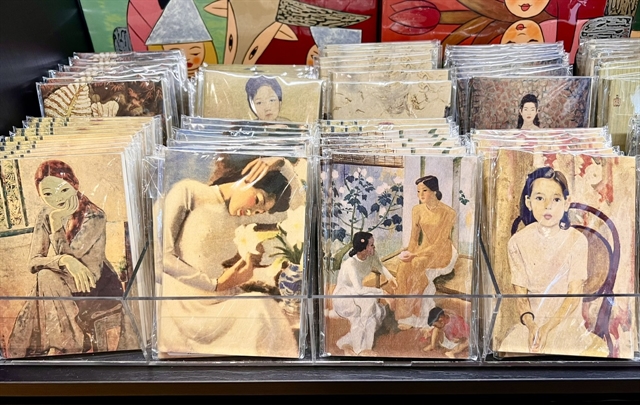 |
| ELEGANT: Notebooks with covers depicting famous paintings of Vietnamese master painters are available for sale at a souvenir shop at the Việt Nam Museum of Fine Arts. — VNS Photo Thúy Hằng |
“We also have a plan to utilize those paintings for designing gift items, which will promote the value of our culture,” she said.
The museum has so far completed a number of experimental products. They include silk scarfs with designs adapted from contemporary paintings, and tote bags indicating the museum logo.
At present, the souvenir shop at the museum is operated by Lá Art – a private company specialising in fine arts products.
“The production of quality products requires a high cost, so we have to cooperate with another party to achieve our goal of promoting our brand through gift products. So far, we have been working with Lá Art to research the taste of customers,” Hương said.
Revenue for tourist sites
In October every year, hundreds of businesses, workshops and artisans working in the handicraft industry nationwide gather in Hà Nội to showcase their products at the Hanoi Giftshow – an international fair on souvenirs and handicraft products held by the city's Department of Industry and Trade.
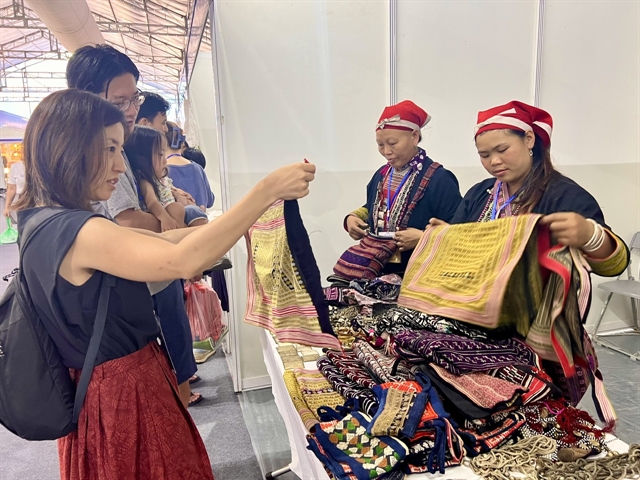 |
| TEXTILES: Japanese visitors enjoy handloom fabric products created by Red Dao ethnic women at the Hanoi Giftshow 2023 in October. — VNS Photo Thúy Hằng |
A major event to promote trading in the handicraft industry, especially for exports, the fair has attracted thousands of domestic and foreign visitors and importers.
Since it was first launched in 2011, the Hanoi Giftshow has become one of the largest export handicrafts fairs in the Asia-Pacific region, with more than 5,000 booths from over 2,250 businesses and establishments from provinces and cities nationwide as well as from more than 30 foreign countries.
According to the organiser, the fair welcomed about 125,000 visitors, of them over 7,000 foreign traders. Thousands of trade contracts for goods distribution with significant value were signed, contributing to an annual export growth in the handicrafts industry of 6 to 8 per cent. The products have mostly been exported to demanding markets such as the EU, UAE, Japan and the US.
“Over the years, the Hanoi Giftshow has had success in bringing Vietnamese handicrafts to clients around the world, promoting exports and sustainable development of Việt Nam’s handicraft industry,” said Trần Thị Phương Lan, acting director of the Hà Nội Department of Industry and Trade.
Commenting on the potential of handicraft products, Deputy Director of Hà Nội Department of Tourism Trần Trung Hiếu said that the capital city, with its thousands-year history and rich culture, had many craft villages.
“The handicrafts created by those villages can be favoured among tourists as gifts, which are diverse in design, materials and price,” he told Việt Nam News.
“Souvenirs are a key source of revenue for many tourist destinations and local businesses. By purchasing souvenirs, tourists are not only bringing home a tangible reminder of their trip, but they are also supporting the local economy and contributing to the sustainability of a tourist destination,” Hiếu added.
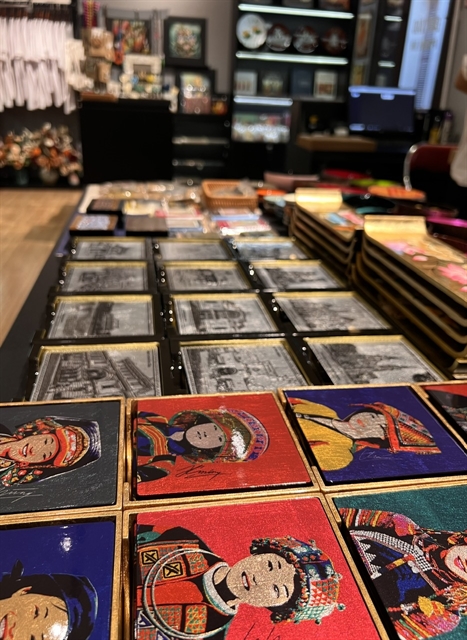 |
| LACQUERWARE: Drink coasters are available for sale at a souvenir shop at the Việt Nam Museum of Fine Arts. Handicraft products created by Vietnamese craft villages are favoured among tourists. — VNS Photo Thúy Hằng |
Currently, Hà Nội is home to more than 1,350 craft villages, accounting for 45 per cent of the total number of such villages in the country. More than 176,000 households are involved in making exquisite products such as wooden objects, wickerwork, ceramics, lacquerware, embroideries, and silk fabrics. — VNS




